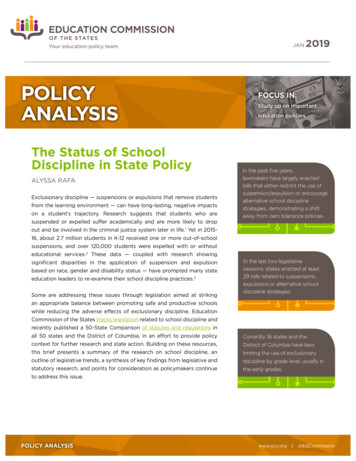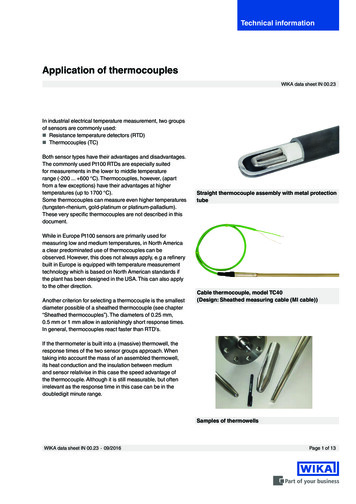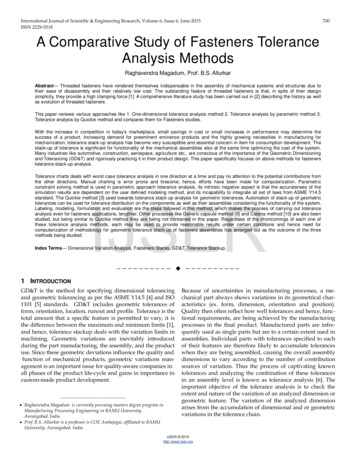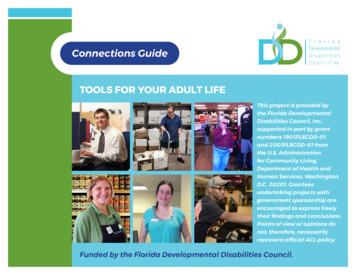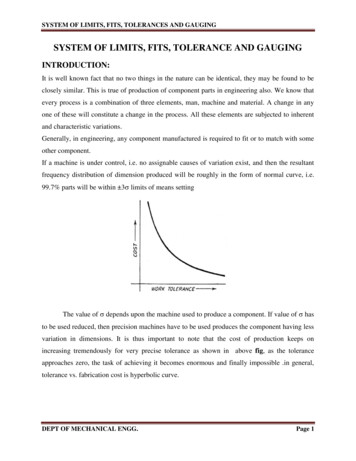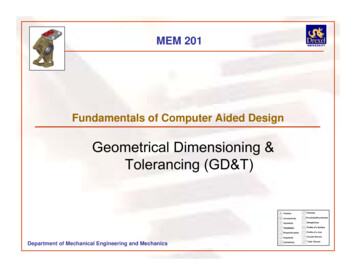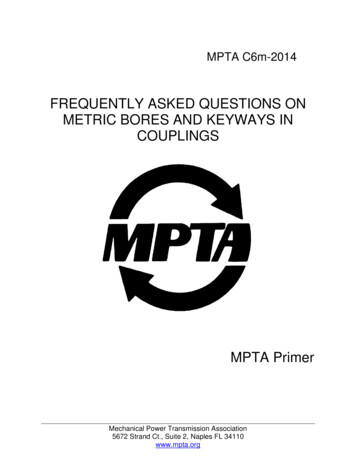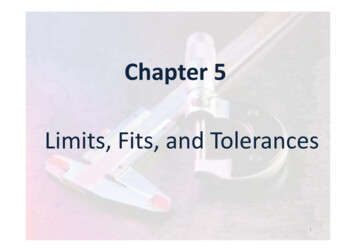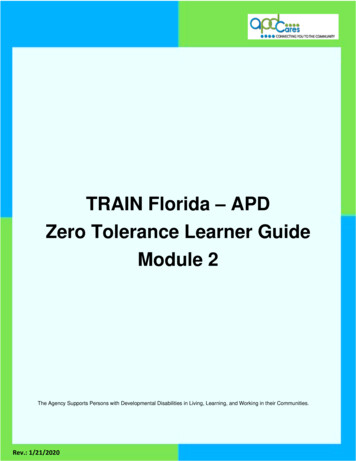
Transcription
TRAIN Florida – APDZero Tolerance Learner GuideModule 2The Agency Supports Persons with Developmental Disabilities in Living, Learning, and Working in their Communities.Rev.: 1/21/2020
Zero Tolerance – Learner GuideModule 2This Page Left Blank IntentionallyRev.: 1/21/2020
Zero Tolerance – Learner GuideModule 2Table of Contents- Module 2Slide No.:Slide TitleSlide 1Module 2- Recognizing the Signs and Symptoms1Slide 2Module 2 Learning Objectives1Slide 3Module 2 Learning Objectives1Slide 4Desire for Power and Control2Slide 5Prevent Abuse by Caregivers2Slide 6Power and Control2Slide 7Power and Control3Slide 8Common Characteristics3Slide 9Common Characteristics3Slide 10Common Characteristics4Slide 11Characteristics of Abuse4Slide 12Characteristics of Abuse4Slide 13Incidence Studies5Slide 14Incidence Studies5Slide 15Abuse Frequency6Slide 16Locations of sexual abuse6Slide 17Signs of abuse and neglect6Slide 18Physical signs of abuse6Slide 19Other physical signs of abuse7Slide 20More Physical signs of abuse7Slide 21Physical Signs of Neglect8Slide 22Behaviors of caregivers who may be abusers8Slide 23Behaviors of Caregivers who may be abusers9Slide 24Behaviors of Caregivers who may be abusers9Slide 25Behaviors of Caregivers who may be abusers9Rev.: 1/21/2020Page
Zero Tolerance – Learner GuideModule 2Slide No.:Slide TitleSlide 26Profiles of abusive caregivers10Slide 27Profiles of abusive caregivers10Slide 28Abusive caregivers may also have:11Slide 29Types of emotional abuse and neglect11Slide 30Types of emotional abuse and neglect12Slide 31Physical Abuse in Caregiving12Slide 32Other signs of physical abuse in caregiving12Slide 33Frightening Physical Actions13Slide 34Physical Signs of Abuse13Slide 35Other physical signs14Slide 36Other Physical Indicators of Concern14Slide 37Other Physical Signs of abuse15Slide 38Physical Signs of Abuse15Slide 39Coma16Slide 40Distinguishing Abuse from Accidental Injury16Slide 41Distinguishing Abuse from Accidental Injury, continued17Slide 42Distinguishing Abuse from Accidental Injury, continued17Slide 43Behavioral Signs of Abuse18Slide 44Behavioral Signs of Abuse18Slide 45Behavioral Signs of Abuse19Slide 46Signs of Exploitation19Slide 47Signs of Exploitation20Slide 48Factors that make it hard to recognize abuse, neglect, andexploitation20Slide 49Factors that make it hard to recognize abuse, neglect, andexploitation21Rev.: 1/21/2020Page
Zero Tolerance – Learner GuideModule 2Slide No.:Slide TitlePageSlide 50The Individual’s Behavioral Signs Of Abuse That May BeInterpreted as Behavioral Problems22Slide 51Conditions of individuals with Developmental Disabilities that canLook Like Abuse or Neglect22Slide 52Conditions Of individuals With Developmental Disabilities ThatCan Look Like Abuse Or Neglect23Slide 53Summary23Slide 54Summary24Slide 55Activity #224Slide 56Next Module24Rev.: 1/21/2020
Zero Tolerance – Learner GuideModule 2Slide 1 – Recognizing the Signs and SymptomsIn this module, you will learn how to recognize the warning signsthat an individual with a developmental disability may be thevictim of abuse, neglect, or exploitation.You’ll also learn some reasons why caregivers may commit suchacts against individuals with developmental disabilities, as wellas, some of the reasons why individuals with developmentaldisabilities are more likely to be abused, neglected, or exploited.Finally, you will learn how to recognize the warning signs that anindividual with a developmental disability is the victim of abuse,neglect, or exploitation.Slide 2 –Learning ObjectivesAt the end of Module 2, you should be able to:Explain how power and control contribute to caregiver abuse.List statistics related to the abuse, neglect, and exploitation ofindividuals with developmental disabilities.State who should report abuse, neglect, and exploitation.Slide 3- Learning ObjectivesAt the end of this module, you should also be able to:Describe strategies to apply when assessing an individual forabuse, neglect, and exploitation.Explain issues to consider when assessing an individual forabuse, neglect, and exploitation.List indicators of abuse, neglect, and exploitation.Rev.: 1/21/2020
Zero Tolerance – Learner GuideModule 2Slide 4 – Desire for Power and Control!Desire for Power and ControlThere is no excuse for abuse and those caregivers who abuseothers must be held accountable for their actions. Understandingcaregiver abuse is the first step toward preventing it fromhappening.Think about this:What happens inside an individual to make them abuse someonewith a developmental disability?On the next slide is the power wheel, which was designed to helpindividuals understand the dynamics of a relationship with acaregiver of an individual with developmental disabilities.Slide 5 - Prevent Abuse by CaregiversPrevent Abuse by CaregiversThis power wheel displays ways to prevent abuse of individualswith developmental disabilities by their caregivers. Non-violenttraits and the examples of those activities are located on thewheel.Turn to page 28 in the Participant's Guide to view the powerwheel.Slide 6 -Power and Control WheelPower and ControlThis Power and Control Wheel for individuals with disabilitiesand their caregivers is designed to help individuals understandthe dynamics of an abusive relationship with a caregiver of anindividual with developmental disabilities. This Power andControl wheel is produced and distributed by the National Centeron Domestic and Sexual Violence. The wheel is credited to theDomestic Abuse Intervention Project as noted.The National Training Project staff may be contacted attraining@theduluthmodel.org.Turn to page 29 in the Participant's Guide for a copy of thePower and Control Wheel for individuals with disabilities andtheir caregivers.Rev.: 1/21/2020
Zero Tolerance – Learner GuideModule 2Slide 7 -Power and ControlThe Power and Control Wheel illustrates eight categories ofabuse: Intimidation. Emotional Abuse. Isolation. Minimize, Justify, and Blame. Withhold, Misuse, or Delay Needed Supports. Economic Abuse. Caregiver Privilege. Coercion and Threats.Slide 8 Common CharacteristicsA number of common characteristics have been identifiedamong individuals with developmental disabilities who havebeen abused, neglected, or exploited. For example, individualswith developmental disabilities are more likely to experience:Multiple forms of abuse, neglect, and exploitation.Multiple perpetrators.Abuse, neglect, and exploitation which lasts for long periods oftime.Inadequate or inappropriate health care.Slide 9 –Common CharacteristicsCommon characteristics that individuals withdevelopmental disabilities are more likely to experienceinclude:Multiple contacts with health care providers and otherprofessionals who:Fail to recognize or respond to abuse, neglect, or exploitation.Ignore, misunderstand, or misinterpret signs and symptoms ofabuse, neglect, and exploitation.Inappropriate use or misuse of prescribed treatments andmedications.Rev.: 1/21/2020
Zero Tolerance – Learner GuideModule 2Slide 10- Common CharacteristicsCommon characteristics are continued with: Misleading caregiver behaviors and statements.Use of the disability to explain or minimize the individual’scondition.Being blamed for injuries or conditions.A lack of concern from professionals and others because ofempathy for caregivers’ responsibilities.Rejection of their reports of abuse, neglect, and exploitationby authority figures.This information was compiled by Steinberg & Hylton, 1998Slide 11 – Characteristics of AbuseSome characteristics of abuse include:Individuals with developmental disabilities are more likely to be: Abused more frequently than others.Abused more severely and for longer periods of time thanindividuals without disabilities.Slide 12- Characteristics of AbuseCharacteristics of Abuse, are continued with:Individuals with Developmental Disabilities are: Rev.: 1/21/2020Less able to escape the abuse or find justice or servicesMore likely to remain in situations that increase theirvulnerability and risk of repeated abuseCaught up in a cycle of abuse that repeats itself
Zero Tolerance – Learner GuideModule 2Slide 13- Incidence StudiesIncidence StudiesA study of over 50,000 school children in Nebraska (Sullivanand Knutson Study, 2000) found that children who wereidentified by their schools as requiring special educationservices were 3.4 times more likely to be maltreated as childrenwho did not need special services.The same study conducted concluded that between 3% and20%.of sexual abuse cases involving individuals withdevelopmental disabilities are actually reported.Turn to page 33 in the Participant's Guide for more information.Slide 14 – Incidence StudiesIncidence Studies, continued:15,000 to 90,000 individuals with developmental disabilities areraped each year in the U.S. Women with developmentaldisabilities are raped and sexually abused at a rate at leasttwice that of the general population of women. In addition, it isestimated that 90% of individuals with developmentaldisabilities will experience sexual abuse at some point in theirlives.Here are some additional statistics:15.2% of children who were found to be sexually abused haddisabilities (Crosse, Kaye, & Ratnofsky, 1993)61% of girls and 25% of boys with disabilities have been foundto be sexually abused before the age of 18 (McArthy andThompson, 1997)Among deaf children, 54% of boys and 50% of girls have beensexually abused. Studies of deaf children in residential schoolsfound that between 50-75% of these children had experiencedsexual abuse (Sullivan, Vernon, & Scanlan, 1987). 40% ofwomen with physical disabilities reported being sexuallyassaulted (Roeher Institute, 1995).38% of women with developmental disabilities who have beenmarried experienced sexual violence by their partners (RoeherInstitute, 1995).Males with developmental disabilities are twice as likely asmales without developmental disabilities to be sexually abusedin their lifetimes (Roeher Institute, 1995).Individuals with intellectual disabilities have been found to beespecially vulnerable to sexual abuse. Between 25-85% ofindividuals with intellectual disabilities have been victims ofsexual abuse. (Morano, 2001).Rev.: 1/21/2020
Zero Tolerance – Learner GuideModule 2Slide 15 –Abuse FrequencyAbuse Frequency Of the individuals who are abused, the larger percentage(64%) have been abused more than 10 times. Those in the2-9 times category make up 17% and the 1 time categoryis 19%. Clearly, abuse is not usually a one-time incidence.Turn to page 33 in your Participant's Guide to see thisinformation.Slide 16- LocationsLocations of sexual abuse:Look at this graph and the locations of sexual abuse have beennotated. The colors in the key shows the name of the locationareas on the graph. The percentages are provided for eachlocation. By looking at the graph, answer this question. “Inwhat location does abuse most frequently occur?” It can bedetermined that “private homes” are the most frequent locationof reported sexual abuse.Turn to page 35 in your Participant's Guide.Slide 17- Signs of Abuse and NeglectSigns of abuse and neglectAs you work with someone with a developmental disability,pay close attention to any changes in appearances orbehavior.Sudden or gradual changes may be signs that abuse orneglect has occurred (or may still be happening).Slide 18- Physical Signs of AbusePhysical signs of abuse are: Rev.: 1/21/2020BruisesBurnsCutsLacerationsBroken bonesSprains
Zero Tolerance – Learner GuideModule 2Slide 19 – Physical Signs of AbuseOther physical signs of abuse are: Abrasions or scrapesVaginal or rectal painBleeding from the ears, nose or mouthFrequent urinary tract infections or yeastinfectionsSlide 20- Physical Signs of AbuseMore Physical signs of abuse are: Painful urinationAbrasions, bleeding, or bruising in the genital areaIncontinence in someone who was previously toilettrainedFrequent sore throatsSudden onset of psychosomatic complaints (malesmost frequently complain of stomach aches whilefemales most frequently report headaches)Sudden difficulty walking or sittingNote that these physical indicators may not be signs ofabuse if they are one-time occurrences or if no othersymptoms are present.Do not assume that the presence of one of these indicatorsautomatically means an individual is being abused.However, you need to consider the possibility that thesephysical signs should be looked at further.Rev.: 1/21/2020
Zero Tolerance – Learner GuideModule 2Slide 21-Physical Signs of NeglectPhysical Signs of Neglect are: Bedsores (the four stages of bedsores are areas ofdead skin caused by sustained pressure cutting offblood flow. The ulcers can range from superficial soresof deep wounds)DehydrationPoor or improper hygieneMalnourishment/weight lossLack of necessary adaptive aidsImproper medication managementAgain, these are physical indicators and may not be signsof neglect if they are one-time occurrences or if no othersymptoms are present. Generally speaking, physical signswill be accompanied by behavioral indicators.Turn to page 38 in your Participant's Guide.Slide 22-Behaviors of Caregivers who may be AbusersIf you work with other caregivers, these are behaviors thatshould trigger your awareness. You should always be on thelookout for certain behaviors that may be indicators thatanother caregiver is an abuser. The following are someexamples of behaviors to make you more observant of thecaregiver.Some of the behaviors of caregivers who may be abusersinclude: Refusal to follow directions or complete necessarypersonal tasksDisplaying controlling attitudes and behaviorsShowing up late or not at allWorking under the influence of alcohol or illegal drugsTurn to page 39 in the Participant's Guide for more informationabout behaviors of caregivers who may be abusers.Rev.: 1/21/2020
Zero Tolerance – Learner GuideModule 2Slide 23-Behaviors of Caregivers who may be AbusersBehaviors of Caregivers, who may be abusers, arecontinued: Abusing or harming pets or service animals Using threats or menacing looks/body language as aform of intimidation Impulsive Using vehicle, money or other resources without consentSlide 24-Behaviors of Caregivers who may be abusersBehaviors of Caregivers who may be abusers can include: Socially isolating individual with a disability (includinglimiting educational and/or employment opportunities)Devaluing the individual with developmental disabilitiesFrequently switching health care providersSpeaking for the individual with developmentaldisabilitiesSlide 25 -Behaviors of Caregivers who may be abusersSome Behaviors of Caregivers who may be abuserscontinue with these examples: Rev.: 1/21/2020Competing with the individual with developmentaldisabilitiesDisplaying unwelcoming or uncooperative attitude duringhome visitsFrequently making attempts to be alone with a particularindividual for no apparent legitimate purpose
Zero Tolerance – Learner GuideModule 2Slide 26-Profiles of abusive caregiversProfiles of abusive caregiversCaregivers who abuse, neglect, or exploit individuals withdevelopmental disabilities are either unable or unwilling toprovide care to these individuals in an appropriate way.It is very important to understand what is going on with thesetypes of caregivers because that will help us develop andimplement prevention strategies (which we will talk aboutlater on in this training).Examples of caregivers who are unable to provide careappropriately may include individuals who are not properlytrained or have the necessary experience to perform theircaregiving duties.The caregiver may have a developmental disability, mentalillness or another medical or health condition themselves.Caregivers who are unable to provide appropriate care mayalso be overly stressed, overly tired or working under theinfluence of drugs or alcohol which limits their ability to workeffectively.Slide 27-Profiles of abusive caregiversProfiles of abusive caregiversCaregivers who are unwilling to provide care appropriatelyare more likely to know that what they are doing is wrong yetthey continue to behave inappropriately.Research shows that these individuals will abuse, neglect, orexploit individuals with developmental disabilities over andover again as long as they are given the opportunity to do so.Some abusive caregivers may not see their victims as actualindividuals (with feelings and emotions).In other cases, caregivers who are unwilling to provideappropriate care to the individuals perceive individuals withdevelopmental disabilities as the perfect victims who, as wewill talk about later, may not be able to defend themselves orinform anyone about the abusive behavior that has happenedto them.Turn to page 39 in your Participant's Guide.Rev.: 1/21/2020
Zero Tolerance – Learner GuideModule 2Slide 28- Abusive caregivers may also haveAbusive caregivers may also have: Low self-esteem A need to control others Frustration with authority, which can lead todisplaced aggression toward weaker individuals A history of being abused or neglected as a child A lack of attachment to the dependent individual,(which can lead to thoughts by the abuser that thevictim does not feel or hurt in response to theirabusive actions)Slide 29- Types of emotional abuse and neglectTypes of emotional abuse and neglectEmotional abuse is the most difficult form of abuse to identify.Even though emotional abuse often happens along with otherforms of abuse, it can also occur by itself. Caregivers whohave power and influence over others’ lives can use thatpower to harm or exploit, rather than to support and nurture.This can be especially devastating for children in theirdevelopmental years, but it can be harmful for anyone. Verbaland emotional abuse can take the form of threats, insultsharassment, and less noticeable forms that are difficult todetect.These can be perpetrated by individuals or by representativesof caregiving systems. Here are some of the most commontypes of emotional abuse and neglect: Rev.: 1/21/2020Exposure to domestic violenceInsults and harassmentDenial of conditions necessary for physical andemotional well-beingDenial of communicationDenial of the right to family life
Zero Tolerance – Learner GuideModule 2Slide 30-Types of emotional abuse and neglectSometimes abuse of individuals with developmentaldisabilities takes the form of acts that could be thought of aswell-intentioned but unsuccessful attempts by the caregiver toensure the individual’s well-being. In other cases, the abuseis deliberate, and is disguised as caregiving. Here are a fewexamples of that type of abuse: Rough physical handlingSudden movements of beddingPushing and pulling andOver-medicationSlide 31-Physical Abuse in CaregivingTypes of emotional abuse and neglect: Denial of social interaction and inclusion Denial of economic stability Denial of rights, necessities, privileges, andopportunities Denial of ordinary freedomsSlide 32- Physical Abuse in CaregivingOther signs of physical abuse in caregiving: Rev.: 1/21/2020Unnecessary or excessive use of restraintsIgnoring dietary restrictionsToileting abuseBath water being too hot or too cold
Zero Tolerance – Learner GuideModule 2Slide 33-Frightening Physical ActionsUsing frightening physical actions that stop just short ofcausing serious physical harm is another form of physicalabuse that is too often used by abusive caregivers ofindividuals with developmental disabilities.Consider how you would feel, if you experienced any of thesesituations. Grabbing individuals with visual impairments frombehindJumping in front of individuals with visual impairments,or trying to trip themAbruptly moving individuals with mobility impairmentsForcing individuals with physical disabilities to movefrom one position to another when they are unfamiliarwith the area, exhausted, or in painSlide 34- Physical SignsPhysical Signs of AbuseQuestionable Bruises:Bruises are among the most common injuries found in childrenand adults with developmental disabilities who have beenabused.It is important to remember that occasional bruising is alsocommon in individuals who are not abused, and thatindividuals with some disabilities may be prone to bruising forother reasons.Here are some of the more common bruises that may indicatesigns of abuse: Rev.: 1/21/2020FacialFrequent, unexplained, or inadequately explainedIn unlikely placesIn various stages of healing
Zero Tolerance – Learner GuideModule 2Slide 35- Physical SignsPhysical Signs of AbuseQuestionable Bruises:Bruises are among the most common injuries found inchildren and adults with developmental disabilities whohave been abused. It is important to remember thatoccasional bruising is also common in individuals whoare not abused, and that individuals with some disabilitiesmay be prone to bruising for other reasons. Here aresome of the more common bruises that may indicatesigns of abuse: Facial Frequent, unexplained, or inadequatelyexplained In unlikely places In various stages of healingSlide 36-Other Physical IndicatorsOther Physical Indicators of Concern include:Questionable cuts and scrapes Frequent, repetitive, unexplained, or inadequatelyexplained scrapes Atypical locations such as mouth, lips, gums, eyes,external genitalia (e.g., places other than palms, knees,or other areas usually covered by clothing) Patterned scarring that may be due to inflicted injuriessuch as whippingBurns or scalds Patterned burns(e.g., shaped like a cigarette butt orelectrical appliance) Burns in specific locations such as several burns ondifferent parts of the body or on particularly sensitivelocations, such as soles, palms, back, or buttocks Immersion burns, which appear sock-like, glove-like, ordoughnut-shaped on buttocks, genitalia, or limbsRev.: 1/21/2020
Zero Tolerance – Learner GuideModule 2Slide 37- Physical SignsOther Physical Indicators of Concern include:Questionable cuts and scrapes Frequent, repetitive, unexplained, or inadequatelyexplained scrapesAtypical locations such as mouth, lips, gums, eyes,external genitalia (e.g., places other than palms,knees, or other areas usually covered by clothing)Patterned scarring that may be due to inflicted injuriessuch as whippingBurns or scalds Slide 38- Physical Signs of AbusePatterned burns(e.g., shaped like a cigarette butt orelectrical appliance)Burns in specific locations such as several burns ondifferent parts of the body or on particularly sensitivelocations, such as soles, palms, back, or buttocksImmersion burns, which appear sock-like, glove-like,or doughnut-shaped on buttocks, genitalia, or limbsDental and mouth injuries Lost or broken teeth, particularly if unrelated to dentaldisease, normal loss of children’s teeth, or accidentalcauses Repeated, unexplained, or inadequately explaineddental injuries Facial bone or jaw fractures Bruising of cheeks and gums at corners of mouth(from gags) Cuts or bruises on the tongue Discoloration of the teeth as a result of previous abuseDislocations of joints Repeated dislocations of joints in the absence of aknown disease process may indicate shaking, twisting,or pulling Frequent or multiple dislocations in the absence of aclear explanation may indicate physical abuseFractures: Repeated or multiple fractures in the absence of aknown disease process or clear explanation mayindicate abuse Old, untreated fractures can indicate chronic abuse Spiral fractures that result from twisting limbs may berelated to abuse in non-ambulatory children and adultswith developmental disabilitiesRev.: 1/21/2020
Zero Tolerance – Learner GuideModule 2Slide 39- ComaComa:Shaking and other forms of abuse can result in a coma ofundetermined origin without external injuries. Comas notassociated with known accidental causes or clearly identifieddisease processes should also be suspected.Turn to page 49 in your Participant's Guide.Slide 40- Distinguishing Abuse from Accidental Injury:Distinguishing Abuse from Accidental Injury:Accidents happen with everyone, including individuals withdevelopmental disabilities. The following is a guide to help tellthe difference between accidental and non-accidental injuries.When observing an injury that might be the result of abuse,consider these factors:Location of the injury:Certain locations on the body are more likely to sustainaccidental injury. These include the knees, elbows, shins, andforehead. Protected body parts and soft tissue areas, such asthe back, thighs, genital area, buttocks, back of legs, or face,are less likely to accidentally come into contact with objectsthat could cause injury.Number and frequency of injuries:The greater the number of injuries, the greater the cause forconcern. Unless the individual is involved in a seriousautomobile accident, he/she is not likely to sustain a number ofdifferent injuries accidentally. Multiple injuries in differentstages of healing are also a strong indicator of chronic abuse.Turn to page 50 in your Participant’s Guide for moredescriptions about distinguishing abuse from accidental injuryRev.: 1/21/2020
Zero Tolerance – Learner GuideModule 2Slide 41- Distinguishing Abuse fromAccidental InjurySlide 42- Behavioral Signs of AbuseRev.: 1/21/2020Distinguishing Abuse from Accidental Injury, continued:Size and shape of the injury: Many non-accidental injuriesare inflicted with familiar objects: a stick, a board, a belt, a hairbrush. The marks which result bear a strong resemblance tothe objects used. Accidental marks resulting from bumps andfalls usually have no defined shape.Description of how the injury occurred: If an injury isaccidental, there should be a reasonable explanation of how ithappened that is consistent with the appearance of the injury.When the description of how the injury occurred and theappearance of the injury are inconsistent, there is cause forconcern. For example, it is not likely that an individual’s fallfrom a wheelchair onto a rug would produce bruises all over thebody.Consistency of injury with the individual’s developmentalcapability: As children grow and gain new skills, their ability toengage in activities that can cause injury increases. A toddlertrying to run is likely to suffer bruised knees and a bump on thehead. Toddlers are less likely to suffer a broken arm than an 8year-old who has discovered the joy of climbing trees.Behavioral Signs of Abuse:Behavioral signs can be extremely important in detectingabuse and neglect, especially in individuals who havecommunication challenges and are unable to tell anyoneabout what happened to them. In many cases, physical signsof abuse may not yet be present or noticed so behavioralsigns are often the first indicators. Usually, it is a combinationof physical and behavioral changes that are seen inindividuals that have been abused. Some of the behavioralsigns of possible abuse are:Aggressive BehaviorIs widespread among victims of abuse;May imitate the aggression committed against the abused anindividual (e.g., the child who is whipped may whip smallerchildren);May generalize to other forms of aggression, such as yellingor hitting others; orMay be exhibited through excessively violent drawings,stories, or play.Atypical AttachmentChildren who have been abused often appear insecure withstrangers, and compulsively seek the presence and attentionof their primary caregivers, yet may express little affectiontowards them.A preschooler may cling to his mother and cry excessivelyboth when she leaves him and when she returns.The individual who has been abused may be uncomfortablewith physical contact with anyone.
Zero Tolerance – Learner GuideModule 2Slide 43- Behavioral Signs of AbuseDisclosureDirect disclosures of abuse, neglect, or exploitation arepowerful evidence, even when some details are incorrect.Complaints of soreness or pain when unrelated to disability orillness. All disclosures should be given attention and referredto the appropriate authorities for full evaluation.FearfulnessVictims of abuse often appear fearful of others:Fear can be specific to the abuser, but may generalize to otherindividualsFear may be age or gender-specific (e.g., the child who turnsaway and raises his or her arms as if to ward off a blowwhenever an adult nearby makes a sudden move)The individual may be afraid to go home, or afraid to leavehome. The child may be afraid to change clothes for gymactivities (may be attempting to hide injuries, bruises), or maybe afraid to take off a long-sleeved shirt even in the heat.Slide 44- Behavioral Signs of AbuseBehavioral Signs of Abuse:Other behavioral signs that can be important in detectingabuse and neglect are:NoncomplianceIndividuals who are abused often become noncompliant.Noncompliance: May be a generalized response to frustration,or an effort to gain personal controlMay be aimed at avoidance of the abuser orthe abusive situationCan take the form of chronically running away(adolescents)RegressionOften children who are abused behave like youngerchildren.This form of regression: May reflect their inability to move through normalstages of development in the face of intenseanxiety Could reflect a mechanism of escape Can be limited to affective and interpersonalbehavior Can extend to developmental skills such as toileting(e.g., a child who was previously toilet trained maybegin to have accidents after experiencing abuse)Rev.: 1/21/2020
Zero Tolerance – Learner GuideModule 2Slide 45- Behavioral Signs of AbuseSleep DisturbanceHaving nightmares or trouble getting to sleep arecharacteristics of abused individuals.This can lead to further abuse due to caregiver frustrationand loss of sleep.Withdrawal Individuals who are abused often withdraw fromothers and spend much of their time alone Sometimes the withdrawal is related to depression Sometimes the individual will alternate betweenwithdrawal and aggression Aggres
Rev.: 1/21/2020 Zero Tolerance - Learner Guide Module 2 Slide No.: Slide Title Page Slide 26 Profiles of abusive caregivers 10 Slide 27 Profiles of abusive caregivers 10 Slide 28 Abusive caregivers may also have: 11

